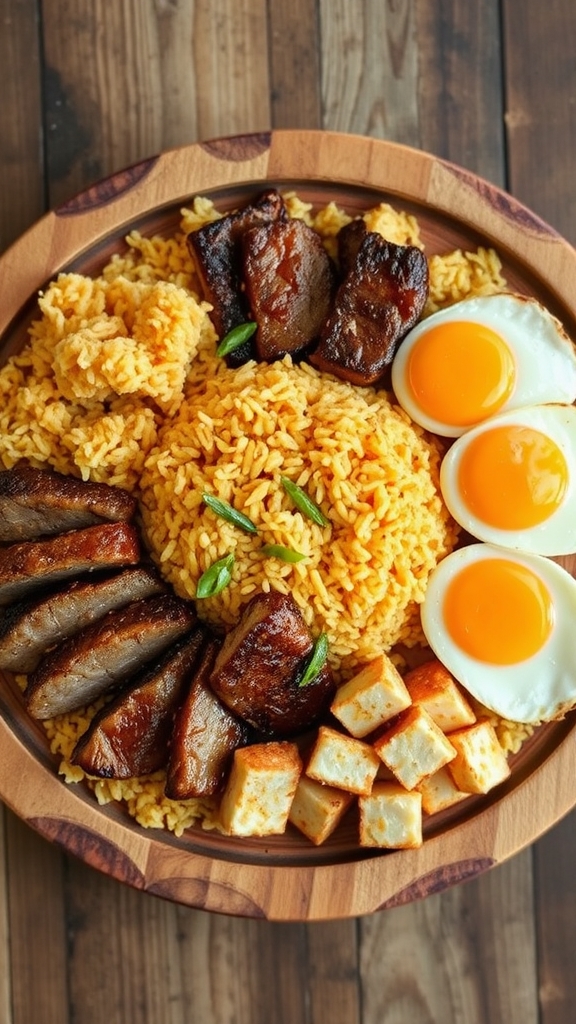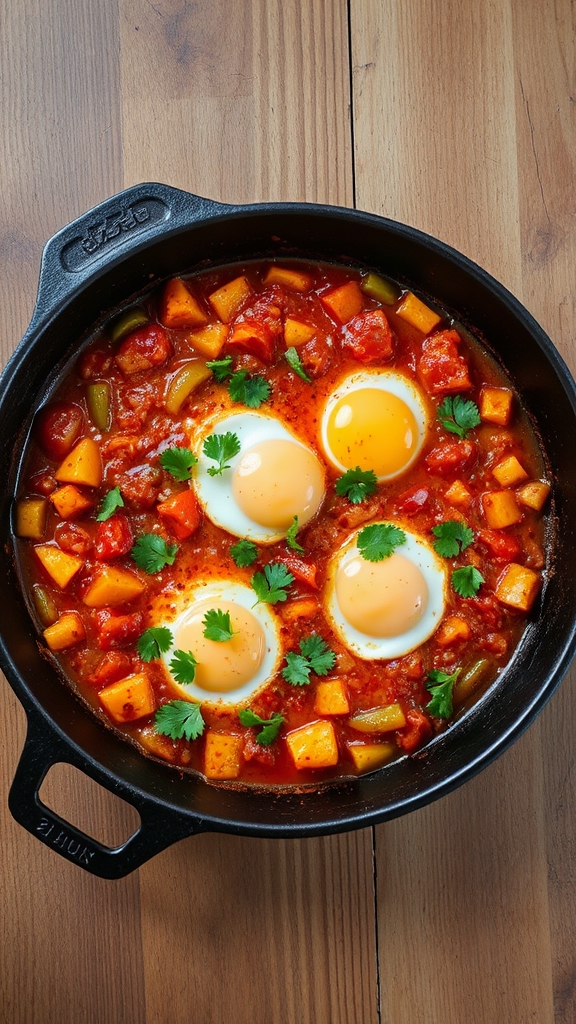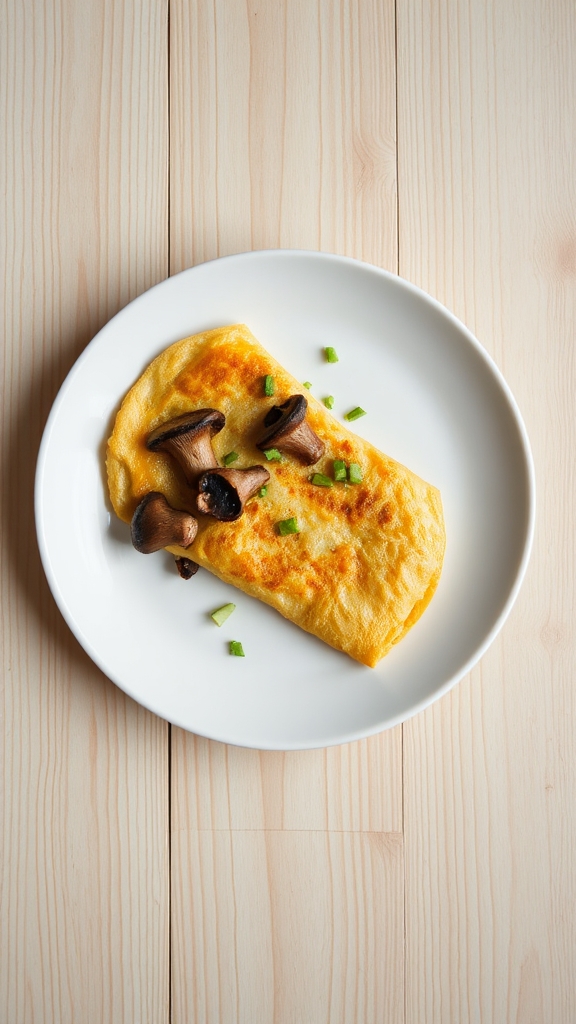Filipino Silog Breakfast Platter
Mix mouthwatering Filipino flavors of garlic fried rice and eggs in the Silog Breakfast Platter, and uncover its rich history that will leave you craving more.

I’m thrilled to share my take on the Filipino Silog Breakfast Platter—it’s a hearty favorite of mine, blending garlic fried rice, sunny-side-up eggs, and marinated meats like beef or sausage for a comforting start to the day. Originating from the Philippines during the American colonial era, it mixes local flavors with Spanish and Chinese twists, offering simple variations for every taste. If you’re curious about the details, there’s plenty more on ingredients and steps just ahead.
History
The Filipino silog breakfast dish originated in the Philippines during the American colonial period, blending local ingredients like sinangag (fried rice) and itlog (egg) with influences from Spanish and Chinese culinary traditions, reflecting the country’s diverse cultural heritage.
Regional variations, such as tapsilog in Luzon with marinated beef or longsilog in the Visayas with garlic sausage, highlight local tastes and available resources, underscoring the significance of regional identity in Filipino cuisine.
Traditionally, silog is served for everyday breakfasts, quick meals, or casual gatherings, symbolizing comfort and simplicity in daily life.
Ingredients
– Sinangag (Fried Rice): Start with about 2 cups of leftover cooked rice—oh, you know, the kind that’s been chilling in the fridge overnight, making it all fluffy and ready to soak up flavors—mixed with 3 to 4 cloves of minced garlic, a couple tablespoons of vegetable oil or maybe that fancy coconut oil if you’re feeling adventurous, and a dash of soy sauce for that salty kick that ties everything together.
It’s the heart of silog, isn’t it, that comforting base that whispers promises of a hearty meal without much fuss?
– Itlog (Egg): Grab 1 or 2 fresh eggs per person, those big ones that crack open with a satisfying pop, fried sunny-side up or maybe scrambled if you’re in a playful mood and want to mix things up.
Eggs are the simple joy here, adding that creamy, protein-packed punch that makes you pause and think, why didn’t I have this every morning?
– Marinated Beef for Tapsilog: If you’re going the tapsilog route, slice up about 200 grams of beef sirloin or flank steak into thin strips—tender ones that cook quick and easy.
Then marinate it in a mix of 2 tablespoons soy sauce, 1 tablespoon vinegar, a teaspoon of sugar for that subtle sweetness, and a pinch of ground black pepper.
It’s like giving the meat a little spa day, turning ordinary beef into something that teases your taste buds with its savory depth, though I might admit, getting the marinade just right can feel like a minor kitchen adventure gone slightly sideways.
– Garlic Sausage for Longsilog: For a longsilog twist, pick up 4 to 6 links of garlic longanisa sausage, the plump ones packed with that bold, garlicky spice that fills the air as they sizzle.
Each link, about 100 grams, brings a smoky, slightly sweet vibe from its curing process, making you wonder how something so straightforward can steal the show.
Especially if you end up with a bit too much char on the edges—hey, we’ve all been there, right?
– Vinegar for Dipping: Don’t forget a small bowl of white vinegar or that tangy spiced sukang pinakurat, maybe 1/4 cup per serving, with a sprinkle of chopped onions and chili for heat.
It’s the unsung hero, adding a zesty contrast that perks up the whole plate, like a cheeky sidekick reminding you that meals are more fun with a little extra flair.
– Fresh Tomatoes and Onions: Slice up 1 medium tomato and half an onion for a quick garnish—crisp, juicy bits that add color and crunch without overwhelming the stars.
They’re like the reliable friends of the dish, always there to freshen things up and make your breakfast look Instagram-worthy, even if your plating skills are, well, a work in progress.
– Optional Veggies for Extra Goodness: Throw in a handful of chopped green beans or spinach, say about 1 cup, if you’re in the mood to sneak in some greens.
It’s that easy add-on that makes you feel all virtuous, turning a simple meal into a balanced one, though who are we kidding, sometimes I ponder if anyone really notices the healthy bits amid all that deliciousness?
– Cooking Oil and Seasonings: Keep on hand 2 to 3 tablespoons of neutral oil for frying everything up—think canola or the everyday stuff—and basic seasonings like salt, pepper, and perhaps a touch more soy sauce.
These are the quiet enablers, the ones that tie flavors together without stealing the spotlight, making you appreciate how a few pantry staples can turn ordinary into oh-so-satisfying.
Cooking Steps
Let’s jump into making your Filipino silog breakfast, where the magic happens in a simple pan and a bit of patience—think of it as a morning ritual that turns humble ingredients into a feast that perks you right up.
First, start with the sinangag: take those 2 cups of leftover cooked rice and heat 2 tablespoons of vegetable oil in a pan over medium heat, then toss in 3 to 4 cloves of minced garlic until it’s fragrant and golden, which only takes a minute or two, you know, before it decides to turn too brown and play tricks on you.
Stir in the rice along with a dash of soy sauce, frying it until each grain is toasty and flavorful, like giving yesterday’s rice a fresh, exciting second chance.
Now, for the protein, it’s all about choices—tapsilog or longsilog, depending on your mood.
If you’re going tapsilog, grab that 200 grams of marinated beef sirloin, which you’ve already soaked in 2 tablespoons soy sauce, 1 tablespoon vinegar, a teaspoon of sugar, and a pinch of black pepper for at least 30 minutes, then sear it in a hot pan for 2-3 minutes per side until it’s juicy and caramelized, but watch out, because flipping too early might leave you with a less-than-perfect sear that teases you later.
For longsilog, take those 4 to 6 links of garlic longanisa sausage, about 100 grams each, and pan-fry them over medium heat for 5-7 minutes until they’re browned and cooked through, releasing that garlicky aroma that makes your kitchen smell like a cozy Filipino spot, even if your timing isn’t spot-on and one side gets a tad crispier than intended.
Finally, fry up 1 or 2 fresh eggs per person in a separate pan with a touch of oil, aiming for sunny-side up so the yolk stays runny and ready to mingle with everything else, or scramble them if you want a softer texture that feels a bit more forgiving on busy mornings.
Once all components are ready, plate your sinangag, add the protein and eggs, then garnish with sliced fresh tomatoes and onions, and serve with a small bowl of 1/4 cup white vinegar for dipping—it’s that zesty touch that ties the meal together, making you pause and think, why not make this a daily habit?
Tips and Variations
If you’re feeling adventurous with your Filipino silog, why not swap out the beef for something like chicken strips marinated in soy sauce and calamansi juice for a lighter twist, or go meat-free with tofu slices fried until crispy to keep that satisfying crunch without the heft—after all, who says breakfast has to stick to the classics when a simple change can turn it into your own creation?
For the sinangag, I might toss in some chopped veggies like bell peppers or green onions right before serving to add a pop of color and nutrients, making it feel extra fresh, or play with the soy sauce by mixing in a bit of fish sauce for that umami kick that sneaks up on you, though if you’re like me and sometimes overdo the seasoning, just taste as you go to avoid turning your rice into a salty surprise.
And for the eggs, while sunny-side up is a favorite, scrambling them with a handful of spinach could make mornings feel a tad healthier, or if you’re prepping ahead, cook the rice and protein the night before so everything reheats quickly, saving you from that rushed, frazzled start that we all know too well.
Tools
| Tool | Purpose |
|---|---|
| Frying Pan | For frying garlic rice, protein, and eggs |
| Knife | For chopping garlic, vegetables, or meat |
| Cutting Board | To provide a safe surface for chopping |
| Spatula | For stirring and flipping ingredients while cooking |
| Measuring Spoons | For accurately measuring seasonings like soy sauce or calamansi juice |
| Bowl | For marinating proteins or mixing ingredients |

Hi There! I'm Stephanie Miller: Elementary teacher from Columbus, OH sharing grandma's treasured American recipes! 50 years young, yoga enthusiast & kitchen storyteller. Welcome to my food family! 🍰❤️












